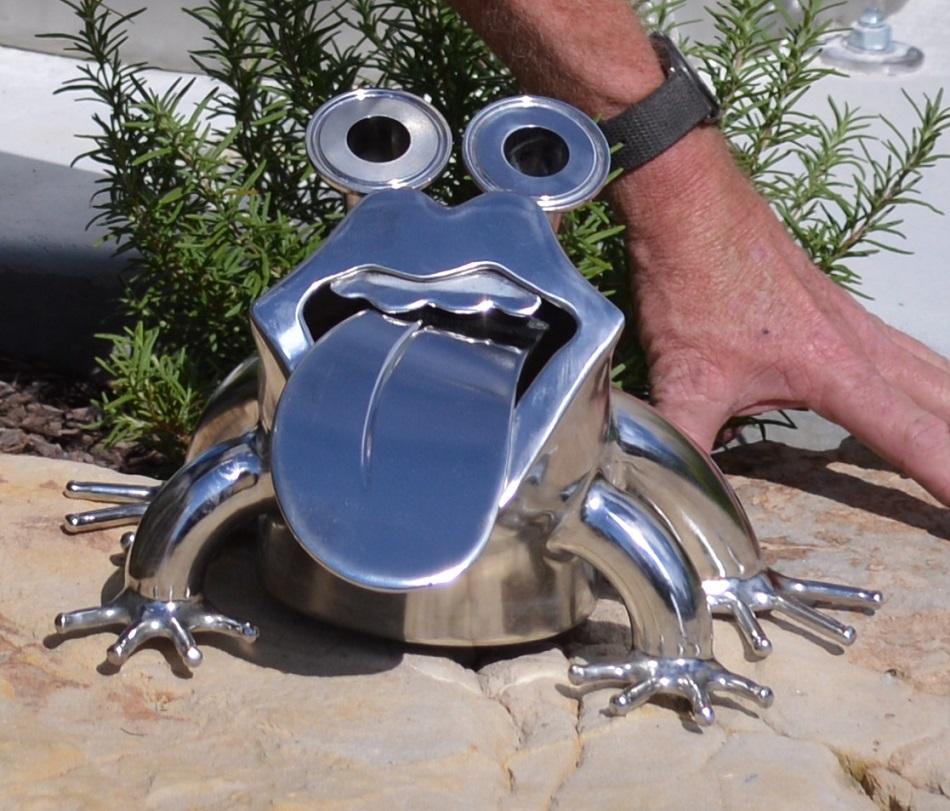- FMA
- The Fabricator
- FABTECH
- Canadian Metalworking
Categories
- Additive Manufacturing
- Aluminum Welding
- Arc Welding
- Assembly and Joining
- Automation and Robotics
- Bending and Forming
- Consumables
- Cutting and Weld Prep
- Electric Vehicles
- En Español
- Finishing
- Hydroforming
- Laser Cutting
- Laser Welding
- Machining
- Manufacturing Software
- Materials Handling
- Metals/Materials
- Oxyfuel Cutting
- Plasma Cutting
- Power Tools
- Punching and Other Holemaking
- Roll Forming
- Safety
- Sawing
- Shearing
- Shop Management
- Testing and Measuring
- Tube and Pipe Fabrication
- Tube and Pipe Production
- Waterjet Cutting
Industry Directory
Webcasts
Podcasts
FAB 40
Advertise
Subscribe
Account Login
Search
Putting together a career as a metal sculptor, one piece at a time
Missouri-based artist acquires skills, scrap steel and other raw materials bit by bit
- By Eric Lundin
- October 17, 2020
- Article
- Arc Welding

A frog created by Cox shows off his welding and finishing savvy. The legs and feet appear to be castings, but they’re not—they’re weldments that have been ground and polished. Images provided by Doug Cox
Like many people, Doug Cox didn’t base his career on a long-range plan. As an 18-year-old high-school graduate in Springfield, Mo., he had two pursuits: work and college. Of course, he hoped that the former would be a means to the latter, and for a while his life went in this direction. “I got a job at A-1 Manufacturing, working as a janitor, then as a sandblaster,” he said. “Eventually I asked to learn to weld. Some of the old-school welders showed me how to weld, and it was good instruction.”
Meanwhile, he attended classes at the local university. He had taken some drafting courses in high school and followed that by taking two first-year art courses, Drawing I and Drawing II. “I always anticipated being a graphic artist,” Cox said. Sandblasting led to finishing, and his welding lessons led to ASME certification. His career was gathering momentum and soon overtook his academic ambitions. He dropped out of school and focused solely on work for a while.
Making the Most of a Mission in Metals
After working in a couple of other metal fabrication shops and sign-making companies over the next several years, Cox landed a job at the Paul Mueller Co., an international firm that specializes in stainless steel equipment and entire systems for processing chemicals, manufacturing pharmaceuticals, processing foods and beverages, and similar applications that require corrosion resistance. Although Cox has a welding certification, he makes his living in finishing.“We do a lot of work to #7 finish,” he said, referring to a process that culminates in 320-grit material and a final buffing stage, resulting in a nearly mirrorlike surface. He eventually took a few more college classes, attending in the evenings, fortifying his education with coursework in sculpture.
Sculptures on Display
Over the past 25 years Cox has used some of his free time, and often scrap items from his employer’s shop, to craft metal sculptures. Initially only family and co-workers knew about his work, but eventually he submitted some pieces for display around Springfield and throughout the state. He learned that working at a creative pursuit often is accompanied by growing thick skin; it’s not uncommon for rejection letters to pile up far faster than acceptance letters.Discouraged, he gave up sculpture for about a decade, but returned to it and was thrilled to find that his fortunes had changed. He has had his works displayed in downtown Springfield for several years now, entries in a year-round event, Sculpture Walk Springfield.
His “Barrel of Monkeys” is currently on display in St. Joseph, Mo., in an exhibit organized by the Allied Arts Council of St. Joseph. “The Amazing Blabadors: Maggie & Rufus,” a rendition of the two Cox Labrador retrievers, is on display at the Humane Society of Southwest Missouri, a donation from Cox. The title cites a somewhat unusual way the two animals communicate, neither bark nor growl, but a mumbling, babbling sound. In the sculpture, the pose is as unique as the way they communicate: One is sitting on the ground, front paws in the air; the other is doing a handstand on the first one’s paws. It represents the frisky nature of Labrador retrievers, which are known for exhibiting playful exuberance well into adulthood.
The sizes, shapes, and details of his sculptures benefit from his career in metals, especially his work in tanks and vessels, and his art classes, going all the way back to high school.First, large sculptures benefit from balance and structural integrity. Cox doesn’t just work out an aesthetic appearance, but strives to make his works sturdy.
“An exterior might be made of 12-ga. material, but often I add 10 ga. in some areas for additional strength, and the interior might have braces and gussets made from even heavier material, like 7 ga.,” he said. A good balance keeps sculptures such as “Barrel of Monkeys” and “The Amazing Blabadors” from tipping.
Second, he also realized that imparting a mirrorlike finish would be a big help in certain sculptures. “Abstract Woman with Factory Air” has an extremely smooth finish overall, but when he makes animal sculptures, he uses the mirrorlike finish selectively. He saves that for eyes and tongues, making them highly reflective, similar to their natural appearance.
Endless Connections, Endless Camaraderie
The phrase “social circle” often is used to describe people who are connected socially, but when Cox talks about friends and acquaintances, he seems to describe a web of overlapping and interconnected relationships, a sprawling network that can’t be summed up simply as a circle. By extension, he gives the impression of regarding nearly everyone and everything as inherently connected. The foundation of an artist’s work is inspiration, and Cox finds his everywhere. He doesn’t see various creative pursuits—such as sculpture, literature, and music—as separate fields, but a continuum. He draws inspiration from writers (Ernest Hemingway), musicians (T Bone Burnett), and artists (Alexander Calder and M. C. Escher) alike.While Cox doesn’t claim to be too savvy with the latest technology, he does post images to his own website and to Instagram. He also found that the websites of Springfield Regional Arts Council (www.springfieldarts.org), First Friday Art Walk (ffaw.org), and many others provide connections, community, and camaraderie for many involved in creating and exhibiting sculptures throughout the area and across the state.

Like many of Cox’s sculptures, “Abstract Woman with Factory Air” took hundreds of hours to complete. He makes just a few sculptures every year, often putting in an hour a day and five or six hours every weekend.
He also found an incredible sense of support when he needed it most. Cox posted to his Facebook page a short explanation about his creations, stating that his art wasn’t intended for any sort of a higher purpose, but mainly for amusement and whimsy. His comment was met with an exceedingly acidic response declaring that his art was neither amusing nor whimsical, and all of it should be melted down and the metal applied to something useful.
More appalled at the perspective—or lack of it—than insulted by the hatefulness of the message, Cox didn’t respond. He didn’t have to. After his Facebook friends in the hundreds came to his defense, and the rebuttals numbered more than 200, the original posting disappeared, taking the entire thread with it.
The support doesn’t start or stop with his hobby. He has high praise for his co-workers and the cooperation they achieve.
“We don’t quite finish each other’s sentences, but the people in Bay 8 work really well together,” he said. “If anyone has a problem or a question, they know who to go to for help. We have a good camaraderie—we have the right guys,” he said.Apparently, many of his co-workers are on this same wavelength; often they help Cox out by setting aside choice pieces of scrap material for him.
About the Author

Eric Lundin
2135 Point Blvd
Elgin, IL 60123
815-227-8262
Eric Lundin worked on The Tube & Pipe Journal from 2000 to 2022.
subscribe now

The Fabricator is North America's leading magazine for the metal forming and fabricating industry. The magazine delivers the news, technical articles, and case histories that enable fabricators to do their jobs more efficiently. The Fabricator has served the industry since 1970.
start your free subscription- Stay connected from anywhere

Easily access valuable industry resources now with full access to the digital edition of The Fabricator.

Easily access valuable industry resources now with full access to the digital edition of The Welder.

Easily access valuable industry resources now with full access to the digital edition of The Tube and Pipe Journal.
- Podcasting
- Podcast:
- The Fabricator Podcast
- Published:
- 04/16/2024
- Running Time:
- 63:29
In this episode of The Fabricator Podcast, Caleb Chamberlain, co-founder and CEO of OSH Cut, discusses his company’s...
- Trending Articles
AI, machine learning, and the future of metal fabrication

Employee ownership: The best way to ensure engagement

Steel industry reacts to Nucor’s new weekly published HRC price

Dynamic Metal blossoms with each passing year

Metal fabrication management: A guide for new supervisors

- Industry Events
16th Annual Safety Conference
- April 30 - May 1, 2024
- Elgin,
Pipe and Tube Conference
- May 21 - 22, 2024
- Omaha, NE
World-Class Roll Forming Workshop
- June 5 - 6, 2024
- Louisville, KY
Advanced Laser Application Workshop
- June 25 - 27, 2024
- Novi, MI



























